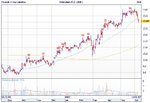tim,
unlesss your "mechanical" system is built from your "discretionary" reasoning - if you see what i mean 🙄
I do indeed Jon, although I suspect you'll need to be a techie genius to write the program based around discretionary criteria!
--------------------------------------------------------------------------------------------------------
The alleged ineffectiveness of candlestick patterns is easy to demonstrate in ShareScope. Recently, they upgraded the software and announced with great glee a new facility enabling subscribers to flag up 12 or so of the most common candlestick patterns. Users can edit which candlestick formations they want to be alerted to so that, for example, the software only searches for bullish engulfing candles. In the chart attached, I've selected the 'show all' option, i.e. all bullish and all bearish patterns.
The stock (SDR) is clearly in a strong uptrend, having risen from around £9.00 to high of £14.00 in nine months. Given this, it is surprising then that there isn't one single bullish pattern alerting a potential long trade. So, anyone looking for prospective long trades would not have had this stock on their radar because no bullish signals were generated. However, any contrarians looking for shorting opportunities would have been alerted to SDR no less than 10 times since Oct 06. With the possible exception of the signal generated in late Feb, the other 9 signals - if acted upon - would probably have resulted in losing trades for the swing or position trader. Not good, not good at all.
There are two obvious conclusions to be drawn from the chart:-
1. that ShareScope's software isn't too hot and needs re-programming!Or . . .
2. that Candlestick patterns don't work.
A quick trawl through the FTSE 100 and NAZ 100 reveal a different type of pattern evident in both markets. When stocks are trending up, bearish patterns are generated and when they are trending down, bullish patterns are generated. So, just as the chart of SDR shows, using these patterns to enter trades is likely to disappoint. However, they may be of some use in exiting part or all of a position or at least in alerting a trader that possible change lies ahead, in the short term at least.
I don't use this facility within ShareScope because it has no value at all for me. It's an unnecessary and unwelcome filter that prevents me from thinking about the forces at play that cause price to move the way that it does. To this end, all candles have some meaning and value and need to be assessed in context. However, in isolation, individual candles are usually pretty meaningless and are more likely to confuse than they are to enlighten.
Tim.

